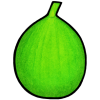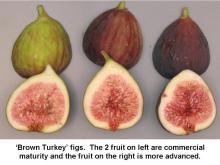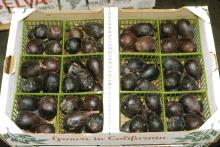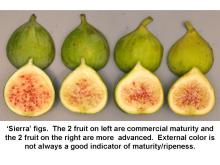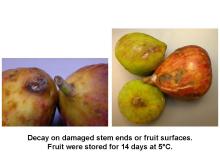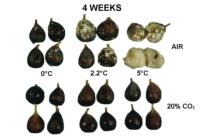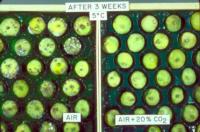Maturity and Quality
Figs intended for sale as fresh fruit must be harvested almost fully ripe to be of good food quality. The color of the skin and the firmness of the flesh are good indicators of maturity and maturation. ‘Black Mission’ figs should be light to dark mauve in color rather than black and should release with the slightest pressure. ‘Calimyrna’ figs should be firm, yellowish white to light yellow in color.
The color of the skin of fresh figs and the firmness of their flesh are linked to their quality and their post-harvest life. Aroma is affected by the stage of ripening and overripe figs may be rejected due to fermentation products. Other quality indicators: absence of defects (e.g., bird beak marks, sunburn, scab, skin cracking and stem wilting), insects, and rot.
Postharvest Handling and Storage
-1°C to 0°C (30°F to 32°F)
Expedited forced-air cooling to 0°C (32°F) is strongly recommended.
| Temperature | 0°C (32°F) | 5°C (41°F) | 10°C (50°F) | 20°C (68°F) |
|---|---|---|---|---|
| ml CO2/kg·hr | 2-4 | 5-8 | 9-12 | 20-30 |
To calculate heat production, multiply ml CO2/kg·hr by 440 to get BTU/ton/day or by 122 to get kcal/metric ton /day.
Figs are slightly sensitive to ethylene action on stimulating softening and decay severity, especially if kept at 5°C (41°F) or higher temperatures.
90-95%
| Temperature | 0°C (32°F) | 5°C (41°F) | 10°C (50°F) | 20°C (68°F) |
|---|---|---|---|---|
| ul C2H4/kg·hr | 0.4-0.8 | 0.8-1.5 | 1.5-3.0 | 4.0-6.0 |
CA combinations of 5-10% oxygen and 15-20% carbon dioxide are effective in decay control, firmness retention, and reduction of respiration and ethylene production rates. Postharvest-life at optimum temperature and relative humidity depends upon cultivar and ripeness stage at harvest and ranges from 1 to 2 weeks in air and from 3 to 4 weeks in CA for California-grown ‘Black Mission’ and ‘Calimyrna" figs.
Temperature & Controlled Atmosphere Photos
Disorders
CA-related disorders. Extended storage in CA can result in loss of characteristic flavor. Figs exposed to less than 2% oxygen and/or more than 25% carbon dioxide develop off-flavors due to fermentative metabolism.
Alternaria rot. Caused by Alternaria tenuis, appears as small, round, brown-to-black spots over the fruit surface. Any cracks on the skin make the fruit more susceptible to the rot.
Black mold rot. Caused by Aspergillus niger, appears as dark or yellowish spots in the flesh with no external symptoms. At advanced stages the skin and flesh turn slightly pink color and white mycelia with black spore masses follow.
Endosepsis (soft rot). Caused by Fusarium moniliforms, appears in the cavity of the fig making the pulp soft, watery and brown with sometimes an offensive odor.
Souring. Caused by various yeasts and bacteria, is a preharvest problem resulting from yeasts and bacteria carried into the figs by insects, especially vinegar flies, resulting in smells of alcohol or acetic acid.
Control of Postharvest Diseases
- Control of orchard insects to reduce fruit damage and transmission of fungi
- Effective control of preharvest diseases
- Strict sanitation of picking and transporting containers
- Careful handling to minimize abrasions, cracks, and other physical damage
- Do not pick figs for fresh market from the ground
- Prompt cooling to 0°C (32°F) and maintaining the cold chain all the way to the consumer



